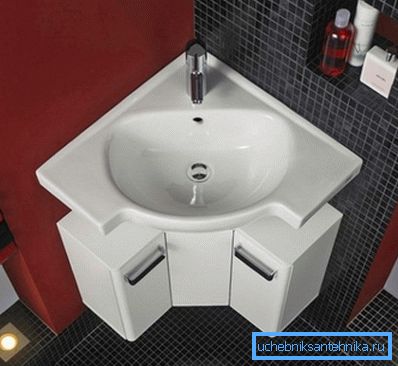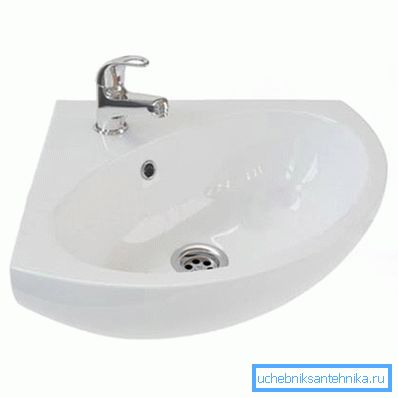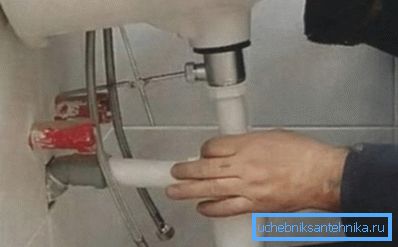Corner washbasin for kitchens and bathrooms
Usually, the premises for water treatment and cooking are not large, therefore compact furniture and the most convenient equipment are installed in them. Corner sink for bathroom and kitchen is becoming very popular, as it saves space.
With its help, functionality sometimes gets unused zone.

Location Benefits
If we compare the corner sinks for the bathroom and kitchen with traditional counterparts, we can distinguish a number of positive points. The following are the advantages of products that are most important in the process of operation.
As for the shortcomings, they are practically absent.
- Products are ideally adapted for convenient use in various conditions.
- The price of devices for the adoption of water procedures of this type is practically no different from ordinary analogues.
- The installation technology is completely similar to the installation of traditional sinks, so the installation process can be done by yourself.
- The space in the corner is used to the maximum, which allows to improve the functionality of the room.
- The bowl itself can have any shape, which means that there are plenty of options for design.

Addition! The dimensions of the corner sink for a bathroom or kitchen can vary greatly, making it possible to select the most suitable products.
Classification of finished products
Any product can be divided into certain categories. This also applies to this product. In the classification, structural features and material are usually taken into account.
By installation method
Depending on the installation technology, there are several types of products. The choice is made taking into account the operating conditions of the products. Below are the most basic options.

Corner sink in the kitchen can be mortise, cap or integrated. In the first case, a hole is made in the tabletop in order to carefully insert the main structure.
Plug-in products are installed on top of the cabinet. Built-in sinks are flush with the surface.
Sinks designed for bathrooms can be suspended, floor or built-in. Suspended models are fixed directly to the wall with dowels and screws.
Floor products are installed through a special stand. Built-in counterparts are integrated into the cabinet.
By production material
- Stainless steel is mainly used in the production of sinks.. For sinks, it almost does not apply. The main advantage of the products is practicality.
- Porcelain and faience - varieties of ceramics. Of them are made as products for bathrooms and for kitchens. Ceramic plumbing fixtures are aesthetically attractive and resistant to chemicals.
- Natural stone looks very impressive, so it is used more often in elegant interiors. Products are characterized by durability and good resistance to mechanical stress.
- Artificial stone is currently being actively used for the production of sanitary ware of this type.. The cost of the instruments is not very high, and the operating parameters are great.
- Tempered glass is perfect for modern interiors. Small corner sinks from this material are very popular. The main advantage is originality in design.
- Acrylic - a new material from the group of synthetic polymers characterized by ease and antibacterial properties. The surface is very smooth, so it is easy to clean.

Reference! Sometimes sanitary plumbing fixtures made of wood are installed in the toilet or bathroom. The main material, as a rule, is larch, oak, teak and other waterproof species.
Installation process
The installation of corner products is practically no different from the installation of more familiar counterparts. Further, it is proposed to consider how a small suspended sink 25x25 is installed for the toilet.
The whole process can be divided into separate stages.

- First, markup is performed directly on the side surface.. Using a tape measure, the distance from the floor to the installation site is measured. It should not be less than 80 cm. The marks are made using a simple pencil, as it leaves no strong marks.
- After marking work is done on making mounting holes, for which a drill is used. Dowels, which allow fixing sanitary fixtures, are driven into the prepared perforation. If the walls are wooden, the fixing is done directly with screws.
- When the sink is fixed, you can proceed to connect to the sewer system. A siphon is installed, to which a corrugated or rigid pipe is screwed. After that, the conductive element is inserted into the sewer issue.
- At the final stage, the mixer is connected by means of a tightening nut.. Feed hoses are connected to cold and hot water pipelines.
Note! If a water trickle appears between the sewage element and the cuff, it is necessary to remove the part and dry the surface. Dry parts should be treated with a sealing agent and reconnected.
Final part
The presented instructions allow you to get detailed information about what may be a corner sink in the kitchen or bathroom. As for the installation process, it is almost the same for all types of products, so there should be no difficulties.
The video in this article provides an opportunity to visually explore the topic.